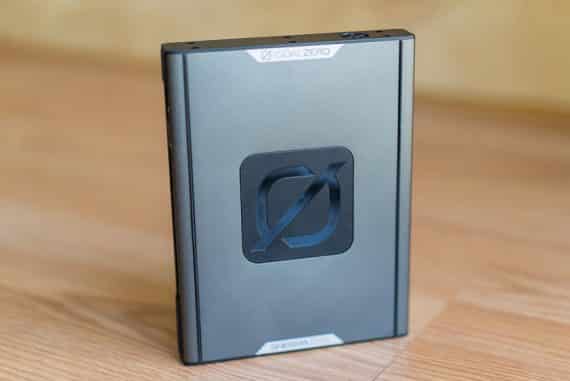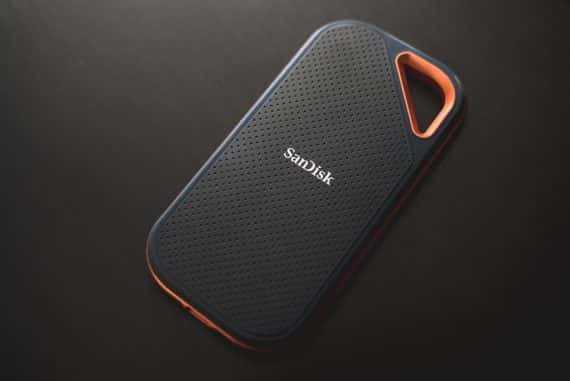
Fuji Instax Share SP-3 Instant Portable Printer Review
The Fuji Instax Share SP-3 is a great portable printer that begs to be used. Print wirelessly from your mobile phone or camera in seconds. Check out our review!
By Greg Cromie
Instant film cameras are certainly not a new thing – they have been around since the late 1940s. And despite popular belief, they were not originally invented by the Polaroid company.
Fujifilm entered the instant camera game with their Fotorama series in the 1980s – today we enjoy the benefits of that heritage with the popular Instax range of instant cameras and printers.
One such Instax printer is the Fujifilm Instax Share SP-3 – a highly portable printer modelled after the Instax SP-2. However, the biggest difference is that the SP-3 delivers square images rather than rectangle ones.
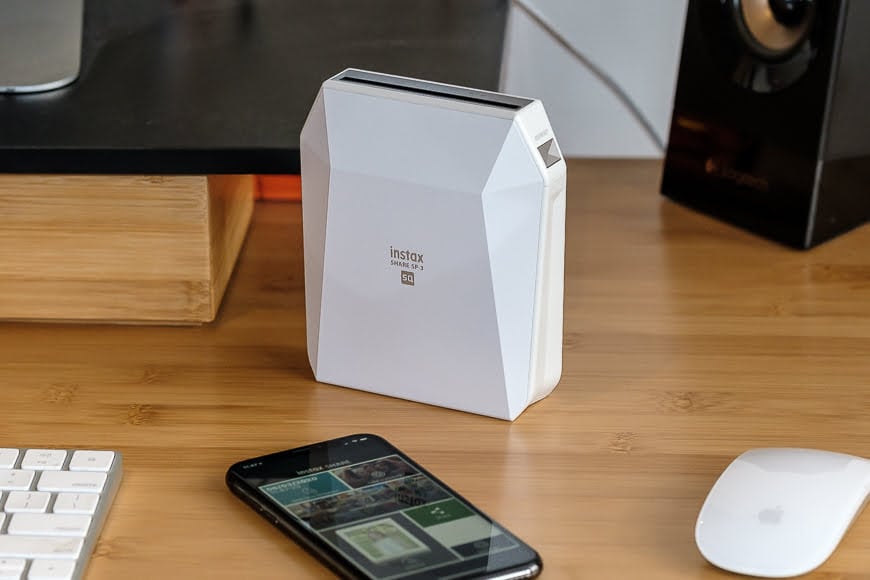

Turn your smarphone photos into fun instant prints while on the go.
Using a square print is a throwback to the earlier Kodak and Polaroid instant cameras. Regardless, the 61mm x 61mm (2.4″ x 2.4″) Instax prints offer more image real estate than the traditional rectangle Instax film.
The idea with the Instax SP-3 printer versus an Instax camera is that with the printer, you can print from any iOS, Android device or Fujifilm X Series camera. Plus, thanks to its compact size, it’s super portable meaning you can take it to parties, events and activities.
With an Instax SP-3, the creative and social application are endless:
Thanks to the ability to apply any text to your print via the Instax SHARE app, you can use the printer as a business card maker.
Alternatively, you can use the printer to print sample portrait images for a photoshoot client. Despite the intended use, the process and applications are a lot of fun.
Let’s take a closer look at this handy little pocket printer.
Fuji Instax Share SP-3 Specs
- Great image quality
- A unique film processing system
- Clever app
- Stylish design
- Creative applications
- Print cartridges are expensive
- Connection drops out randomly
- Dimensions: 116 mm x 130.5 mm × 44.4 mm (4.56″ x 5.13″ x 1.74″)
- Weight: 312g (0.31lb)
- Print size: 61mm x 61mm (2.4″ x 2.4″)
- Prints per charge: 160
- Full recharge time: 3 hours
- Print size: 6.1cm x 6.1cm (2.4” x 2.4”)
- Print time: 25 seconds
- Processing time: 2-3 minutes
- Power: rechargeable battery via included USB cable
- Colours: black or white
Build & Appearance

The Fujifilm Instax Share SP-3 is sleek and well designed.
Much like the Fuji Instax SP-2, the SP-3 is a neat size that’s light and very portable.
For size comparison, it’s about the same as a good-sized sandwich – as a result, you can pack it in your school or work bag.
The body of the printer is made from a hardened plastic that has a slight pearl finish – the printer is available in both white and black. The build quality is excellent and typical of Fuji products.
Thanks to the use of angular edges, the irregular shape of the Fuji SP-3 creates the deception that the printer looks smaller than it actually is. Plus, this design is minimal, contemporary and would look great on any desk.
Each side of the Instax SP-3 features a single button. On one side, there’s the power button and on the other is a reprint button that allows you to print the last image over and over.
The front of the printer showcases branding and model information.
The rear has a single lever that when shifted, allows the film-cartridge door to spring open. Once you’ve loaded your cartridge, you simply push the door closed, and it latches tight to ensure the film within is not accidentally exposed.

A Fujifilm Instax Share SP-3 printer looks right at home on a creative’s desk.
The base of the Fuji Instax SP-3 has two hidden panels – one is to install the rechargeable battery, and the other is to house the USB charge port. A USB charge cable is included in the box.
The top of the printer is where all the action happens. There’s a long slit that’s sealed with soft material – this is where the prints are ejected, and the padded material squeezes shut to prevent any light leaking into the printer.
There’s a single LED to indicate battery performance and a row of ten LEDs that indicate how many shots are left inside the film cartridge.
That’s pretty much all there is to it – simple and minimal with a great look.
I thought I would quickly touch on the print cartridges while we are here. The cartridge comes wrapped in a sealed foil bag to prevent any unwanted light leakage exposing the film or air from ruining the processing fluids. The plastic cartridge forms the shape of a box that holds the film within.
Unfortunately with the Instax cartridges, there’s a lot of plastic waste as once you have shot your pack of ten prints, the cartridge is thrown away.
Overall, the Fujifilm Instax Share SP-3 is probably the best looking portable printer on the market.
Ergonomics & Handling
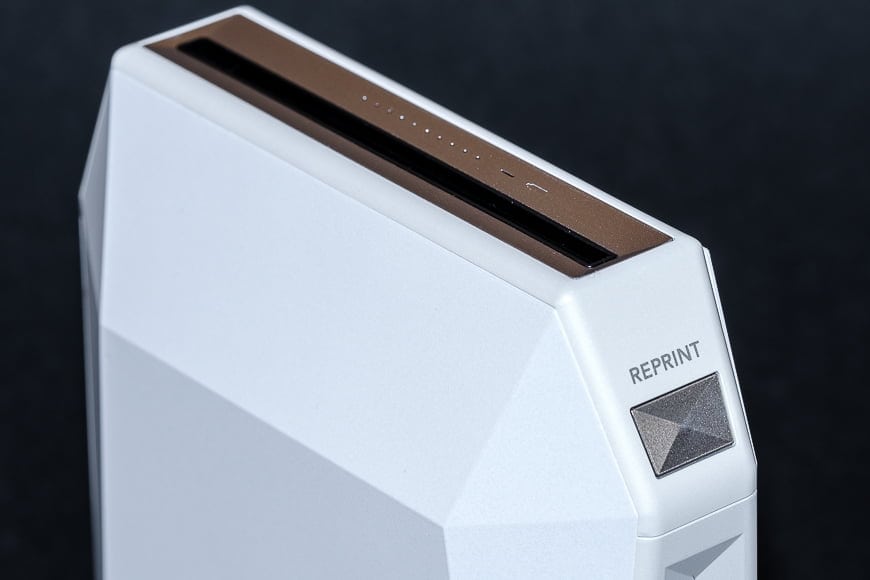
The reprint button on the Fujifilm Instax Share SP-3 is used more often than you think.
As mentioned, the Fujifilm Instax Share SP-3 is a very simple and minimal printer whose function is pretty straight forward – this technology has not changed much in a long time.
Once you unpack your printer, you will want to give it a good charge.
A full charge takes about three hours, but the battery will last for ages – approximately 160- shots on a full charge. You will run out of film before you run out of battery life.
The next step is to load a Fujifilm Instax SQ film cartridge into the printer. Opening the printer door is much easier than opening the foil enclosing the film cartridge – those suckers are tough.
Loading the cartridge into the SP-3 is simple, provided you line up the yellow indicator on the inside of the printer with the yellow indicator on the cartridge.
Once the film is loaded and the door is shut, you may get a surprise to find that the printer ejects a black plastic sheet.
Don’t be alarmed as this is just the cartridge cover that prevents the film from being exposed when loading – you can throw this away too.
While this is happening the ten LED indicators will do a little light show for you and then settle on all ten LEDs lit.
Also, it’s very important to not open the cartridge access door partway through using your printer as you will likely expose the remaining prints.

If the Fujifilm Instax Share SP-3 is the body, then the accompanying Fuji Instax SHARE app is the brains of the operation. The app supports both iOS and Android and is very simple to use and well laid out – more importantly, it has a number of clever and creative features.
The first of which is the ability to take an image from within the app with your smart device camera. From there you can review the image as well as apply a template and edits.
The editing functions are fairly limited; however, there are three filters that can by applied – Intelligence, Black & White and Sepia. You can also use a Custom Filter function where you can adjust Brightness, Contrast and Saturation.
The final edit function allows you to rotate the image up to 180 degrees in fine increments of 1 degree at a time. There’s also a zoom function where you can zoom in to 400% in 1% increments.
The Instax SHARE app allows you to print images that already exist on your phones image gallery. Further to this, you can pull images from your Instagram and Facebook accounts.
There are a couple of handy templates in this section where you can either split the image across two prints or create a collage on a single print. What’s brilliant about this feature is that you can opt to also have an overlay of information.
The overlay will take information from your social media profile, including your icon, image description and the number of likes the image has gained. You can also select images from other online services such as Google, Dropbox and Flickr.
I love that you can use the Fuji Instax SP-3 to print images directly from a Fujifilm X Series camera.
At a party I photographed, I would take images with my Fuji X-T3 camera and then print them wirelessly to the printer.
The party guests could take their print and stick it into a guest book along with a written message for the birthday boy. It generated a lot of buzz, and the guests loved the playfulness of the printed images.

That’s me, by the way.
The app has a brilliant feature where you can apply a real-time template that will include the date, time, location, and weather from the precise moment you took the image. This is great for those that are using the Instax SP-3 for some form of real-time project.
The app’s share feature allows you to select an image that you ‘ve printed previously, and then share it to your device’s gallery, Dropbox, Google and Flickr. This way, you’ve both a digital and printed copy of exactly the same image, including edits.
The My Template feature of the app is great as you can create a custom template with an image and text. These could be used as business cards perfect for the creative type. You can choose from a selection of templates and then adjust the size, colour and placement of the text.
Finally, there’s a reprint option that when pressed, will bring up a gallery of every image that you’ve previously printed.
The biggest issue with the Instax Share SP-3 tech is the way you connect to the printer with your iOS or Android device. While it only takes a few moments for the app to locate the printer, I found that the connection constantly failed.
This mostly occurred in between prints while I was using the app to edit an image. Granted that this was sometimes as a result of the printer power-saving function – it’s certainly not a deal-breaker but an annoyance none-the-less.
Image Quality
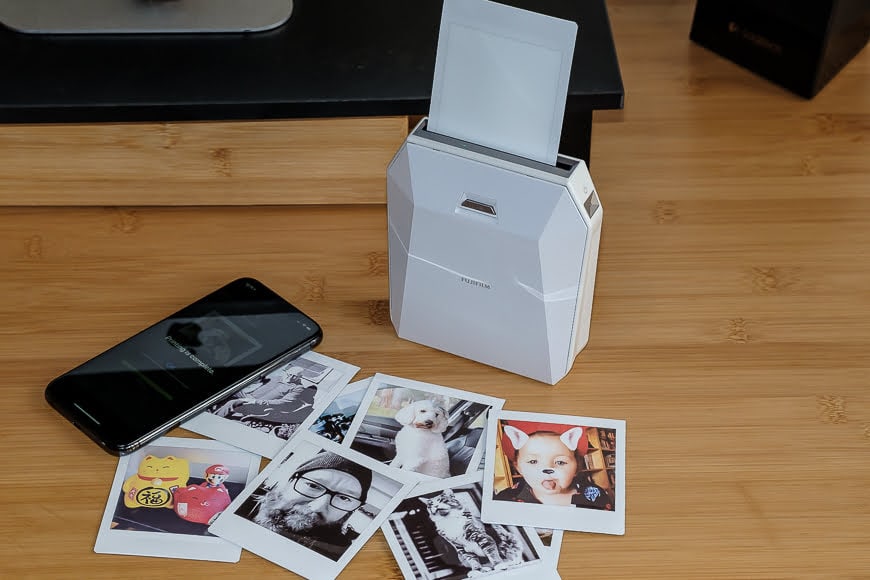
The Fujifilm Instax Share SP-3 creates images that are bright and sharp with strong resolution.
Once you’ve made your selection and added filters and edits, it’s time to print the image via the Instax SHARE app.
It takes around 10 seconds between pressing the print button on your device and the Instax SP-3 starting to work its magic. It then takes 13 seconds for the print to eject from the printer.
Your print will appear white at first, and after around 30 seconds, the image will start to appear. It can take a few minutes for the full processing effects to kick in and give you a fully developed image with rich contrast.
Despite popular belief, it is best not to waggle your print in the air – this does nothing to speed up the processing time.
Images produced by the Fujifilm Instax SP-3 are bright, crisp and have a great level of contrast. The prints have an image size of 800 x 800 dots with a printing resolution of 318 dpi.
Of course, the image is only going to be as sharp as the camera that took it. The same goes for colour and contrast.
Regardless, colour reproduction, tonal qualities and the white balance are perfect.
As this is not a digital print, the images have a true film-quality to them – there’s a little grain that really adds to the appeal of the image.
So how does the Fujifilm Instax Share SP-3 actually create a printed image in such a tiny box? As much as I would love to say it’s wizardry, there’s a lot of ingenious Fuji chemistry behind it.
The SP-3 uses an old-school technology that was first developed halfway through the last century – more commonly people associate this kind of technology with Polaroid cameras.
The Fuji Instax print has a reservoir of processing fluid held within the broader section of the print frame. The print itself is a form of photographic paper that has the image imposed on it by a light flashed within the printer.
As the print slowly ejects from the printer, the processing fluid is squeezed evenly across the whole surface of the photographic paper. As a result, the processing chemicals do their magic and react with the paper to create the image. Brilliant and still a little like wizardry.
The prints themselves are physically robust thanks to the material choice by Fuji. The actual print area is 61mm x 61mm (2.4″ x 2.4″) and the total print frame is 72mm x 86mm (2.84″ x 3.39″) making them a perfect size for creative uses like scrapbooking, journaling and creating collages.
And while it is not indefinite, the print quality should last for decades provided that the prints are stored correctly without excessive exposure to light, heat and moisture.
Overall Performance
Overall, the Fujifilm Instax Share SP-3 is a brilliant little photography companion ideal for the mobile device shooter.
If you own a Fujifilm X Series camera like one of these, then you’ve got a perfect opportunity to print your images while on the go.
The printer is light and compact, making it perfect to drop into a camera or carry bag the next time you’re headed out to an event.
The functionality of the printer is simple and thanks to a long history of tech development by Fuji, will last as long as you have film. A single battery charge will last up to 160 shots – that’s industry-leading performance compared to other portable printers.
As for the app, this is a clever product that provides some very creative options for having a lot of fun with your SP-3 – I just wish Fuji would update it with a few more filter styles.
The app is user-friendly with some great real-time and text-based templates perfect for time-based projects.
It only takes moments to edit, print and see your print magically appear from the Instax SP-3. Then a few minutes later, you have a high-resolution print to use and share.
If your friends love your image, you can hit that reprint button until everyone gets a copy – I actually did this at a family Christmas lunch a couple of years ago.
The Fujifilm Instax Share SP-3 performs surprisingly well and adds a whole new element to photography with a smartphone.
Value for Money

The Fujifilm SHARE app is simple and effective with lots of creative applications.
In terms of value, the Fujifilm Instax Share SP-3 is very affordable at around $90 – remember you have the choice between a black or white printer.
The benefit of getting the SP-3 over the SP-2 is that you have larger prints with more print area. As a result, your images have much more context and story in them.
The flip side to the low cost of the SP-3 portable printer is the cost of the actual print cartridges. The cost-per-print is a lot more expensive than other portable printers.
This is primarily because the Fuji Instax SQ film is using complex technology that’s expensive to produce – most other brands of printer use a ZeroInk system.
A cartridge of 10 SQ prints is going to cost around $17, or $1.70 per print, so it’s best to be selective of what you end up printing. My advice is to buy in bulk as Fuji offer larger boxes with up to four 10x print cartridges.
There are also a few different variations of the Fujifilm Instax SQ instant film that have different coloured frames on the print.
Overall, a portable printer like this one would make an ideal ideal gift – I know I’d love to receive one this Christmas!
Fuji Instax Share SP-3 Review | Conclusion
One of the best things about the Fujifilm Instax Share SP-3 portable printer is that right out of the box you can be printing your own images within minutes – setup is faster in fact than the best home photo printer.
I know that I personally found it very inspirational to go through my (ridiculous amount of) images on my phone and print my best ones instantly.
Having a portable printer like the SP-3 opens up creative applications and before too long you will be dreaming up projects for your prints. Imagine creating hard copy photo books, a mini-exhibition in your smallest room or even printing images to accompany your travel journal entries.
I gave an Instax portable printer to my teenage daughter along with a black paged sketchbook, a glue stick and a silver gel pen. It is now up to her what she chooses to document and explore.
The Fujifilm Instax Share SP-3 is a brilliant portable printer that looks great and combines old-school science with high-end tech. The result is a perfect companion for your photographic journey and education.


Turn your smarphone photos into fun instant prints while on the go.







